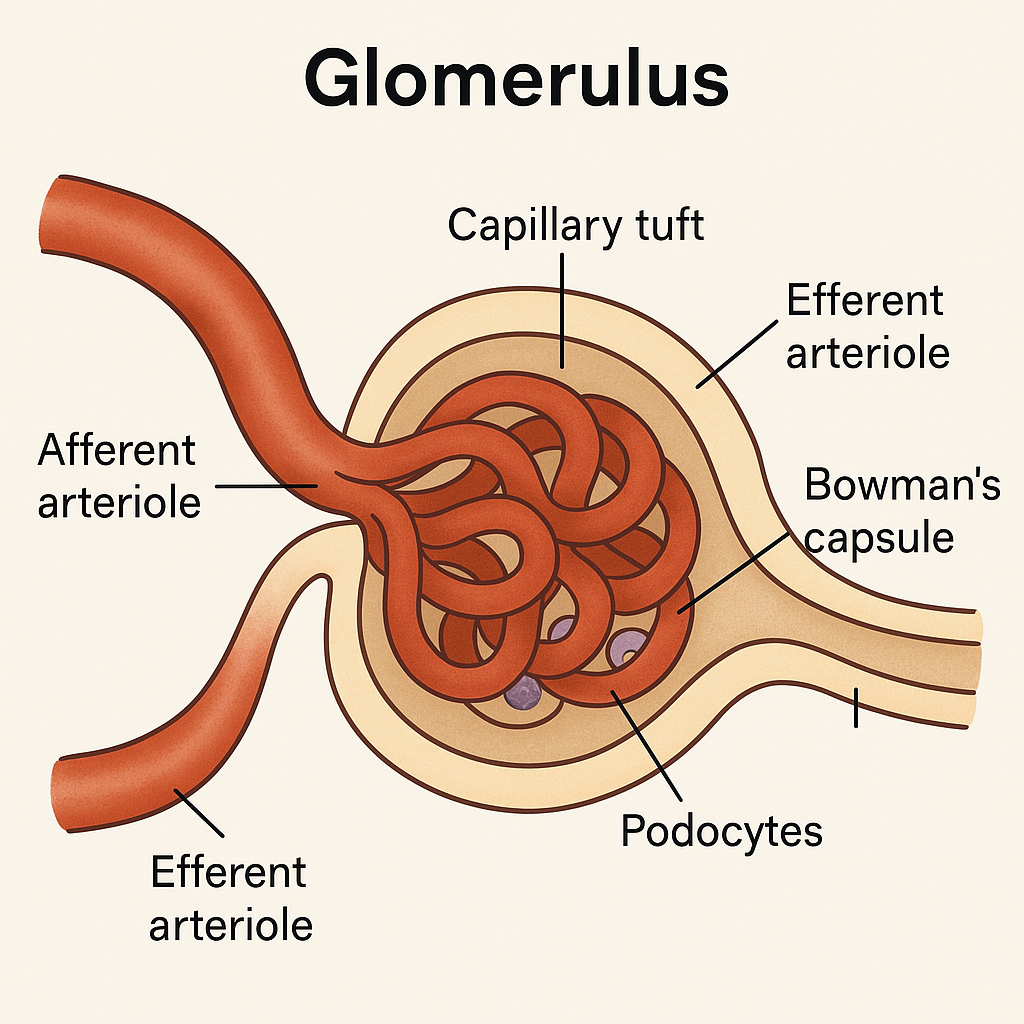Notes on Human Glomerulus: Structure and Function, Urinary System, Excretory System MCQ with Answer
Structure of Glomerulus
The glomerulus is a network of capillaries located at the beginning of a nephron in the kidney. It is enclosed within a Bowman’s capsule and plays a crucial role in the process of urine formation.
Key structural components:
-
Afferent arteriole: Brings blood into the glomerulus.
-
Capillary tuft: A cluster of capillaries where filtration occurs.
-
Efferent arteriole: Carries blood away from the glomerulus.
-
Bowman’s capsule: A cup-like sac that surrounds the glomerulus and collects the filtrate.
-
Podocytes: Specialized cells lining the inner layer of the Bowman’s capsule, helping with filtration.
-
Basement membrane: A semipermeable structure that acts as a barrier and filter.
⚙️ Function of the Glomerulus
The primary function of the glomerulus is filtration of blood. It initiates the process of urine formation through:
-
Ultrafiltration:
-
Blood pressure forces plasma minus large proteins and cells through the glomerular membrane into Bowman’s capsule.
-
This fluid is called glomerular filtrate.
-
-
Selective Permeability:
-
Allows water, glucose, salts, amino acids, and urea to pass through.
-
Retains large molecules like proteins and blood cells.
-
-
Filtration Rate:
-
The rate at which the glomerulus filters blood is known as the glomerular filtration rate (GFR).
-
Normal GFR is about 125 mL/min in adults.
-
-
Where is the glomerulus located?
a) In the liver
b) In the nephron of the kidney
c) In the heart
d) In the urinary bladder
✅ Answer: b -
What is the function of the glomerulus?
a) Reabsorption
b) Secretion
c) Filtration
d) Excretion
✅ Answer: c -
Which arteriole brings blood into the glomerulus?
a) Efferent arteriole
b) Renal vein
c) Afferent arteriole
d) Peritubular capillaries
✅ Answer: c -
What type of pressure drives filtration in the glomerulus?
a) Osmotic pressure
b) Oncotic pressure
c) Hydrostatic pressure
d) Atmospheric pressure
✅ Answer: c -
Which structure collects the filtrate from the glomerulus?
a) Loop of Henle
b) Bowman’s capsule
c) Proximal tubule
d) Renal pelvis
✅ Answer: b -
What does not pass through the glomerular filtration barrier?
a) Glucose
b) Water
c) Proteins
d) Urea
✅ Answer: c -
Podocytes are found in which part of the nephron?
a) Collecting duct
b) Bowman’s capsule
c) Loop of Henle
d) Distal tubule
✅ Answer: b -
What is the normal GFR in healthy adults?
a) 60 mL/min
b) 90 mL/min
c) 125 mL/min
d) 200 mL/min
✅ Answer: c -
Which arteriole is smaller in diameter in the glomerulus?
a) Afferent arteriole
b) Efferent arteriole
✅ Answer: b -
The glomerular basement membrane is mainly responsible for filtering based on:
a) Size and charge
b) Color
c) Temperature
d) Speed of flow
✅ Answer: a
